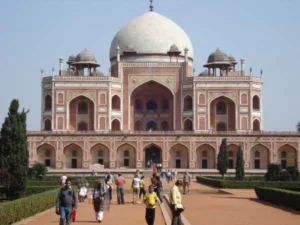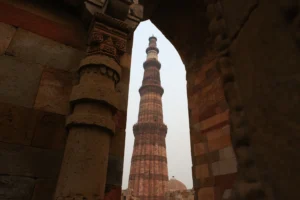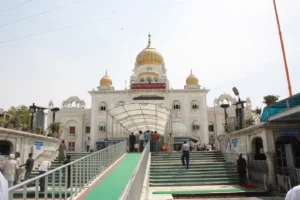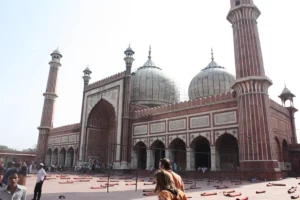Delhi
Additional Historical Information
It generally has been presumed that the city was named for Raja Dhilu, a king who reigned in the 1st century BC, and that the various names by which it has been known (Delhi, Dehli, Dilli, and Dhilli) have been corruptions of this name. Besides being at the political center of the country, Delhi is also a focal point in India’s transportation network.
 Delhi has been the capital city of a succession of mighty empires or powerful kingdoms, and numerous ruins mark the sites of the various cities. According to popular tradition, the city has changed its locality a total of seven times, although some authorities, who take smaller towns and strongholds into account, claim it has changed its site as many as 15 times. All these locations are confined to a triangular area of about 70 square miles called the Delhi triangle.
Delhi has been the capital city of a succession of mighty empires or powerful kingdoms, and numerous ruins mark the sites of the various cities. According to popular tradition, the city has changed its locality a total of seven times, although some authorities, who take smaller towns and strongholds into account, claim it has changed its site as many as 15 times. All these locations are confined to a triangular area of about 70 square miles called the Delhi triangle.
 Almost each emperor created a new city near the old city. The last time Delhi became a capital again was in 1911 when the then ruling British decided to move the capital of British India from Calcutta to Delhi, laying the foundation for the ‘eightth city’ of Delhi, which came to be known as New Delhi. Edward Luytens, the most well known architect of his age was chosen to design the city, and his architectural conceptions were totally different from the Hindu or Mughal architecture. When you walk through the center of New Delhi, you will find yourself in a the last imperial city that was ever built with such extravagance. The city center has wide, straight avenues in a strict layout, plenty of parks and low colonial buildings with spacious gardens.
Almost each emperor created a new city near the old city. The last time Delhi became a capital again was in 1911 when the then ruling British decided to move the capital of British India from Calcutta to Delhi, laying the foundation for the ‘eightth city’ of Delhi, which came to be known as New Delhi. Edward Luytens, the most well known architect of his age was chosen to design the city, and his architectural conceptions were totally different from the Hindu or Mughal architecture. When you walk through the center of New Delhi, you will find yourself in a the last imperial city that was ever built with such extravagance. The city center has wide, straight avenues in a strict layout, plenty of parks and low colonial buildings with spacious gardens.
The Cathedral Church of the Redemption, while resembling a miniature (London’s) St Paul’s Cathedral, derives both name and inspiration from Palladio’s Church of Il Redentore in Venice. Its perfectly English neo-classical interior complete with dark wood paneling, dim religious lighting and a plain and boldly linear exterior was built between 1927-35 and consecrated in 1931, to be the centre of Anglican worship for the British officials of the day. Today it is the diocese of the Bishop of the Church of Northern India.
 There are many noteworthy Gurudwaras (places of worship for the Sikhs). Shish Ganj was built on the land where the ninth Sikh Guru Sri Guru Tegh Bahadur (1621 – 1675) was martyred by the Mughals. He together with three of his disciples were murdered at night, but because of fear of the Mughals, nobody came to pick the bodies up that night. The next day the head was taken to Anandpur Sahib and the body to where Gurudwara Rakab Ganj is now situated. A century later a devotee named Baba Baghel Singh searched for, and found this place and had this place of worship constructed here. Also Gurudwara Bangla Sahib where Guru Har Krishan (1656 – 1664), the eight Sikh Guru went to Delhi at the invitation of Raja Jai Singh and the sangat (Sikhs) of Delhi stayed as the honored guest of the Raja
There are many noteworthy Gurudwaras (places of worship for the Sikhs). Shish Ganj was built on the land where the ninth Sikh Guru Sri Guru Tegh Bahadur (1621 – 1675) was martyred by the Mughals. He together with three of his disciples were murdered at night, but because of fear of the Mughals, nobody came to pick the bodies up that night. The next day the head was taken to Anandpur Sahib and the body to where Gurudwara Rakab Ganj is now situated. A century later a devotee named Baba Baghel Singh searched for, and found this place and had this place of worship constructed here. Also Gurudwara Bangla Sahib where Guru Har Krishan (1656 – 1664), the eight Sikh Guru went to Delhi at the invitation of Raja Jai Singh and the sangat (Sikhs) of Delhi stayed as the honored guest of the Raja

In South Delhi is another marvel, the Bahai Temple. A distinctive lotus shaped wonder in marble, is often called as the Taj Mahal of the 21st century. The lotus, inseparably associated with worship and religion, the symbol of beauty and purity, enshrining the idea of light and growth, was motivating inspiration for the architect’s design. The temple consists of a prayer hall, a library, a reception center and offices. All around the lotus are walkways which surround the nine pools representing the floating leaves of the lotus.

Jama Masjid is one of the largest mosques in India. It’s also known as ‘Masjid-I-jahan Numa’ (Jahan means ‘World’ and Numa means -‘Visible’), situated a quarter of a mile from the Red Fort, designed as Emperor Shahjahan’s principal mosque. Construction lasted six years, ending in 1644. The structure was placed on a high platform so that it’s magnificent facade would be visible from all the adjoining areas. It’s an austere yet beautiful building. As with the other buildings of Shahjahanabad, this one was also in red sandstone with white marble being used extensively, specially in the three domes (white marble inlaid with stripes of black). The pulpit is one of its best features, being carved out of a single block of marble. The mosque has three gateways, four angle towers and two minarets which stand 40 metres (130 feet) high and are constructed of alternating vertical strips of red sandstone and white marble. Of the three gates, the eastern gate was reserved for the Emperor when he used to arrive here every Friday and on Id. About 20,000 people can pray at a time in this mosque.
